一、Linux线程VS进程
1.进程和线程
- 进程是资源分配的基本单位
- 线程是调度的基本单位
- 线程共享进程数据,但也拥有自己的一部分数据:
- 线程ID
- 一组寄存器(上下文)
- 栈
- errno
- 信号屏蔽字
- 调度优先级
2.进程的多个线程共享
同一地址空间,因此Text Segment、Data Segment都是共享的,如果定义一个函数,在各线程中都可以调用,如果定义一个全局变量,在各线程中都可以访问到,除此之外,各线程还共享以下进程资源和环境:
- 文件描述符表
- 每种信号的处理方式(SIG_ IGN、SIG_ DFL或者自定义的信号处理函数)
- 当前工作目录
- 用户id和组id
进程和线程的关系如下图:
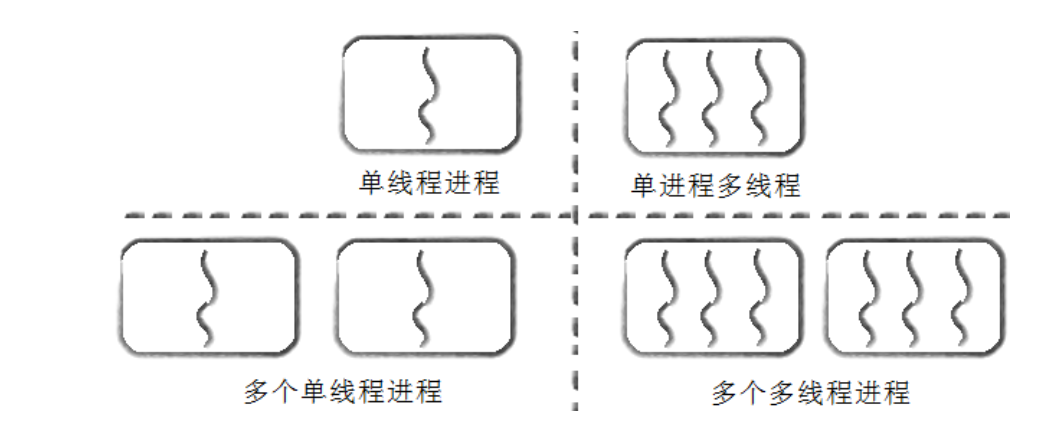
3.关于进程线程的问题
如何看待之前学习的单进程?具有一个线程执行流的进程
二、线程控制
1.POSIX线程库
内核中有没有很明确的线程的概念呢?没有的。它只有轻量级进程的概念。
所以它就一定无法给我们提供线程的系统调用,只会给我们提供轻量级进程系统调用!
可是我们用户,需要的是线程的接口!**所以我们的应用层就有了一个pthread线程库。它是将轻量级进程接口进行了封装。为用户提供直接线程的接口。**对于这个pthread线程库,几乎所有的linux平台,都是默认自带这个库的!在Linux中编写多线程代码,需要使用第三方pthread库!
- 与线程有关的函数构成了一个完整的系列,绝大多数函数的名字都是以“pthread_”打头的
- 要使用这些函数库,要通过引入头文<pthread.h>
- 链接这些线程函数库时要使用编译器命令的“-lpthread”选项
2.快速使用一些常见的接口
2.1 创建线程
#include <pthread.h>
int pthread_create(pthread_t *thread, const pthread_attr_t *attr,
void *(*start_routine) (void *), void *arg);
- thread:返回线程ID,是一个输出型参数
- attr:设置线程的属性,大部分情况下,attr为NULL表示使用默认属性
- start_routine:是个函数地址,线程启动后要执行的函数,返回值为void*,参数也是void*,他是新线程所执行的入口函数。void*可以接收或返回任意指针类型,因为C语言没有模板,但是想用泛型。注意在linux平台下,指针是8字节,因为是64位机器,并且void的大小是1,且不可以形如void x这样定义变量
- arg:传给线程启动函数的参数。创建线程成功,新线程回调线程函数的时候,需要参数,这个参数就是给线程函数传递的。没有就设置位nullptr
- 返回值:成功返回0;失败返回错误码。

然后我们用如下代码来进行验证
#include <iostream>
#include <pthread.h>
#include <unistd.h>
using namespace std;void* threadRountine(void* args)
{while(true){cout << "new thread, pid" << getpid() << endl;sleep(2);}
}int main()
{pthread_t tid;pthread_create(&tid, nullptr, threadRountine, nullptr);while(true){cout << "main thread, pid" << getpid() << endl;sleep(1);}return 0;
}
运行结果为
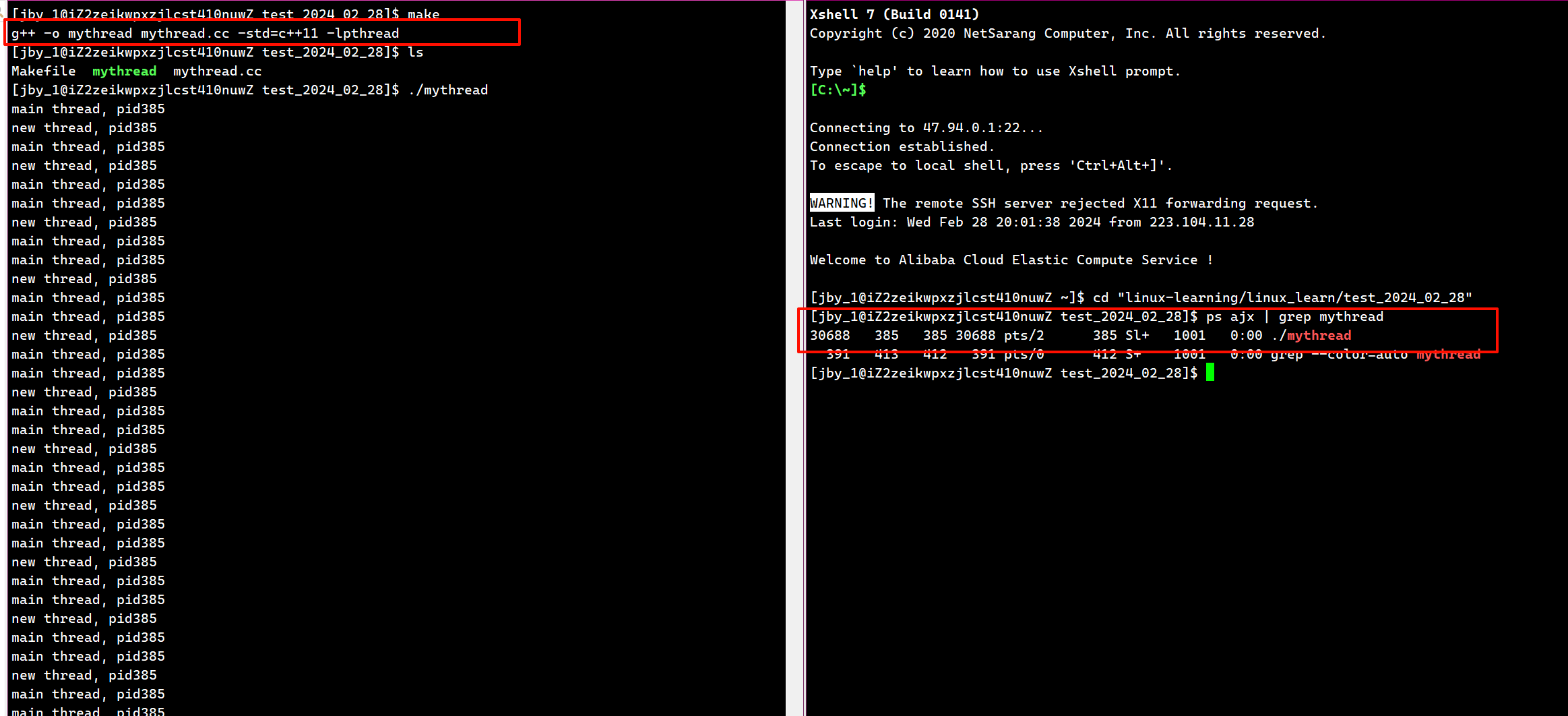
注意我们可以发现,它只有一个pid,说明它确实是一个进程,只不过一个进程里有两个执行流
可是如果我们就想查到两个该怎么办呢?我们可以用如下命令
ps -aL #这里的L我们可以理解为light轻的意思,也就是轻量级进程
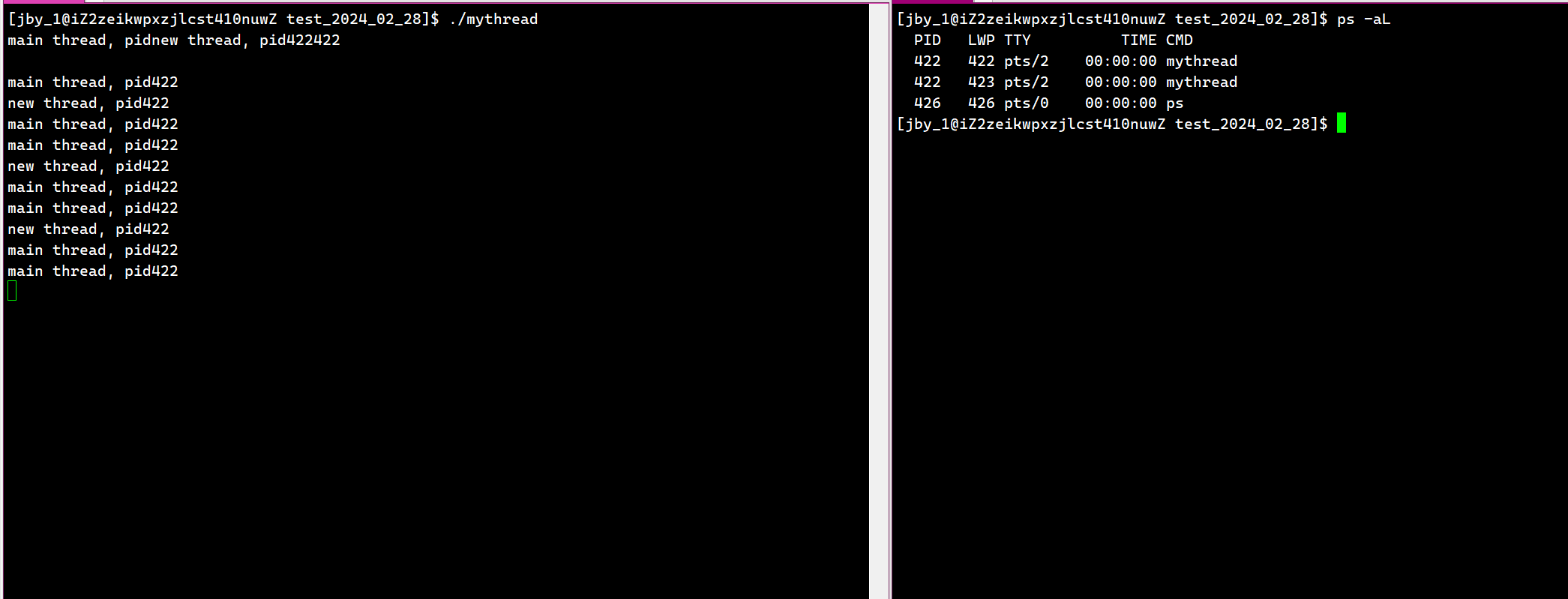
其中第二个LWP(light weight process)其实就是轻量级进程的意思。因为轻量级进程也需要有一个编号
其中有一个PID等于LWP,这里说明了这个线程是主线程,剩下的是被创建出来的线程
像我们以前写的单线程代码,其实就是PID永远等于LWP的。
除此之外,一个进程中的任何一个线程被干掉了,那么整个进程都会被干掉
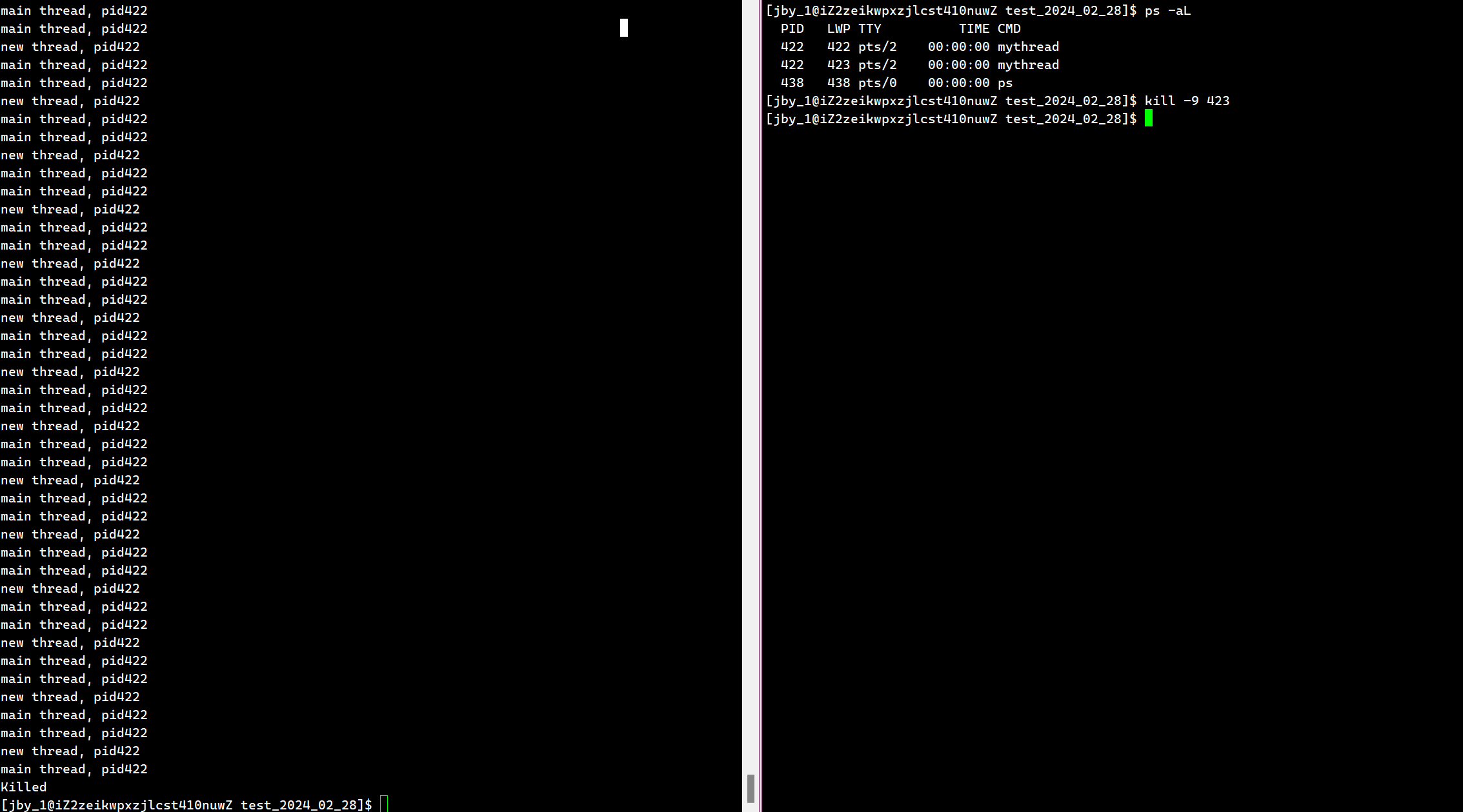
那么这个信号是发给进程还是线程的呢?,其实是发给进程的。因为线程只是进程的一个执行分支。这也就是为什么线程的健壮性很差,因为一个线程被干掉了,其他线程也会被干掉。
我们在看一下下面的代码:
#include <iostream>
#include <pthread.h>
#include <string>
#include <unistd.h>
using namespace std;void show(const string& name)
{cout << name << "say# " << "hello thread" << endl;
}void* threadRountine(void* args)
{while(true){cout << "new thread, pid" << getpid() << endl;show("[new thread]");sleep(2);}
}int main()
{pthread_t tid;pthread_create(&tid, nullptr, threadRountine, nullptr);while(true){cout << "main thread, pid" << getpid() << endl;show("[main thread]");sleep(1);}return 0;
}
运行结果为
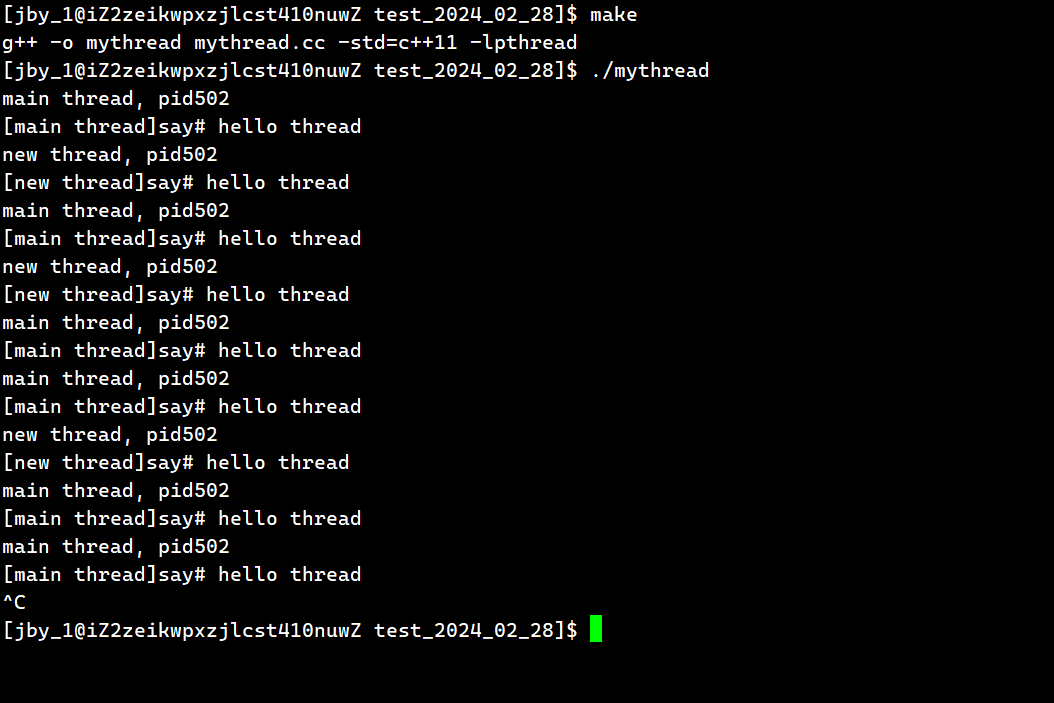
我们可以看到主线程和新线程都调用了这个方法,说明这个函数可以被多个执行流同时执行。即show函数被重入!
我们还可以看下面的代码
#include <iostream>
#include <pthread.h>
#include <string>
#include <unistd.h>
using namespace std;
int g_val = 100;void show(const string& name)
{cout << name << "say# " << "hello thread" << endl;
}void* threadRountine(void* args)
{while(true){printf("new thread, pid:%d, g_val:%d, &g_val:0x%p\n", getpid(), g_val, &g_val);// cout << "new thread, pid" << getpid() << endl;//show("[new thread]");sleep(2);}
}int main()
{pthread_t tid;pthread_create(&tid, nullptr, threadRountine, nullptr);while(true){printf("main thread, pid:%d, g_val:%d, &g_val:0x%p\n", getpid(), g_val, &g_val);// cout << "main thread, pid" << getpid() << ", g_val" << g_val << "&g_val" << &g_val << endl;//show("[main thread]");g_val++;sleep(1);}return 0;
}运行结果为
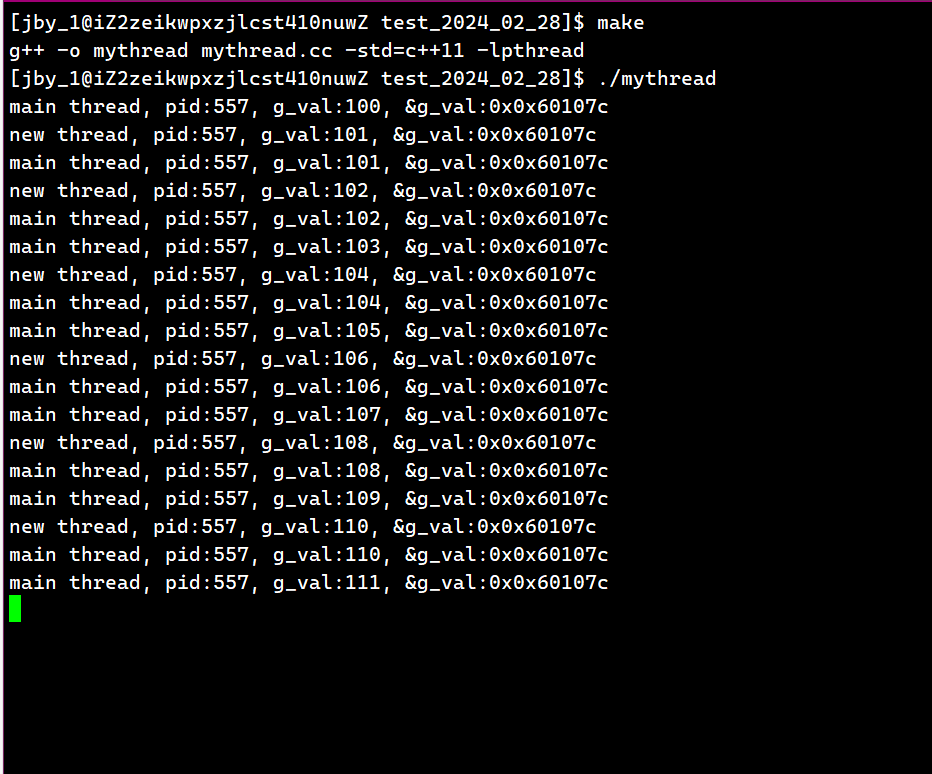
我们可以看到,主线程和新线程都可以看到这个变量被修改了。说明两个线程共享这个变量。
所以两个线程想要进行通信实在是太容易了
我们再用下面的代码进行测试
#include <iostream>
#include <pthread.h>
#include <string>
#include <unistd.h>
using namespace std;
int g_val = 100;void show(const string& name)
{cout << name << "say# " << "hello thread" << endl;
}void* threadRountine(void* args)
{while(true){printf("new thread, pid:%d, g_val:%d, &g_val:0x%p\n", getpid(), g_val, &g_val);// cout << "new thread, pid" << getpid() << endl;//show("[new thread]");sleep(5);int a = 10;a = a / 0;}
}int main()
{pthread_t tid;pthread_create(&tid, nullptr, threadRountine, nullptr);while(true){printf("main thread, pid:%d, g_val:%d, &g_val:0x%p\n", getpid(), g_val, &g_val);// cout << "main thread, pid" << getpid() << ", g_val" << g_val << "&g_val" << &g_val << endl;//show("[main thread]");g_val++;sleep(1);}return 0;
}
运行结果为:
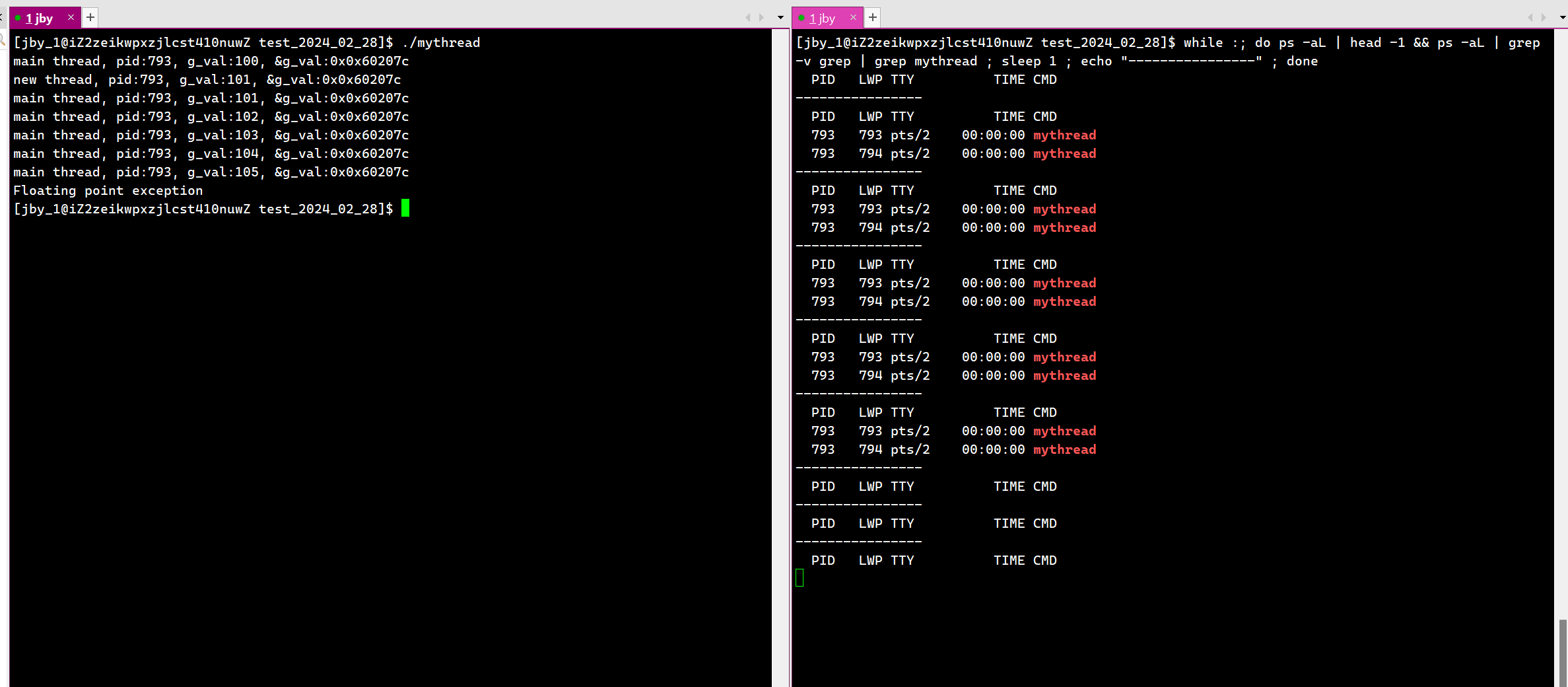
这就是因为一个线程出现异常了,所以导致整个进程挂掉了
我们接下来在看一下这个tid是什么
#include <iostream>
#include <pthread.h>
#include <string>
#include <unistd.h>
using namespace std;
int g_val = 100;void show(const string& name)
{cout << name << "say# " << "hello thread" << endl;
}void* threadRountine(void* args)
{while(true){printf("new thread, pid:%d, g_val:%d, &g_val:0x%p\n", getpid(), g_val, &g_val);// cout << "new thread, pid" << getpid() << endl;//show("[new thread]");sleep(1);// int a = 10;// a = a / 0;}
}int main()
{pthread_t tid;pthread_create(&tid, nullptr, threadRountine, nullptr);while(true){printf("main thread, pid:%d, g_val:%d, &g_val:0x%p, creat new thread tid:%p\n", getpid(), g_val, &g_val, tid);// cout << "main thread, pid" << getpid() << ", g_val" << g_val << "&g_val" << &g_val << endl;//show("[main thread]");g_val++;sleep(1);}return 0;
}运行结果为
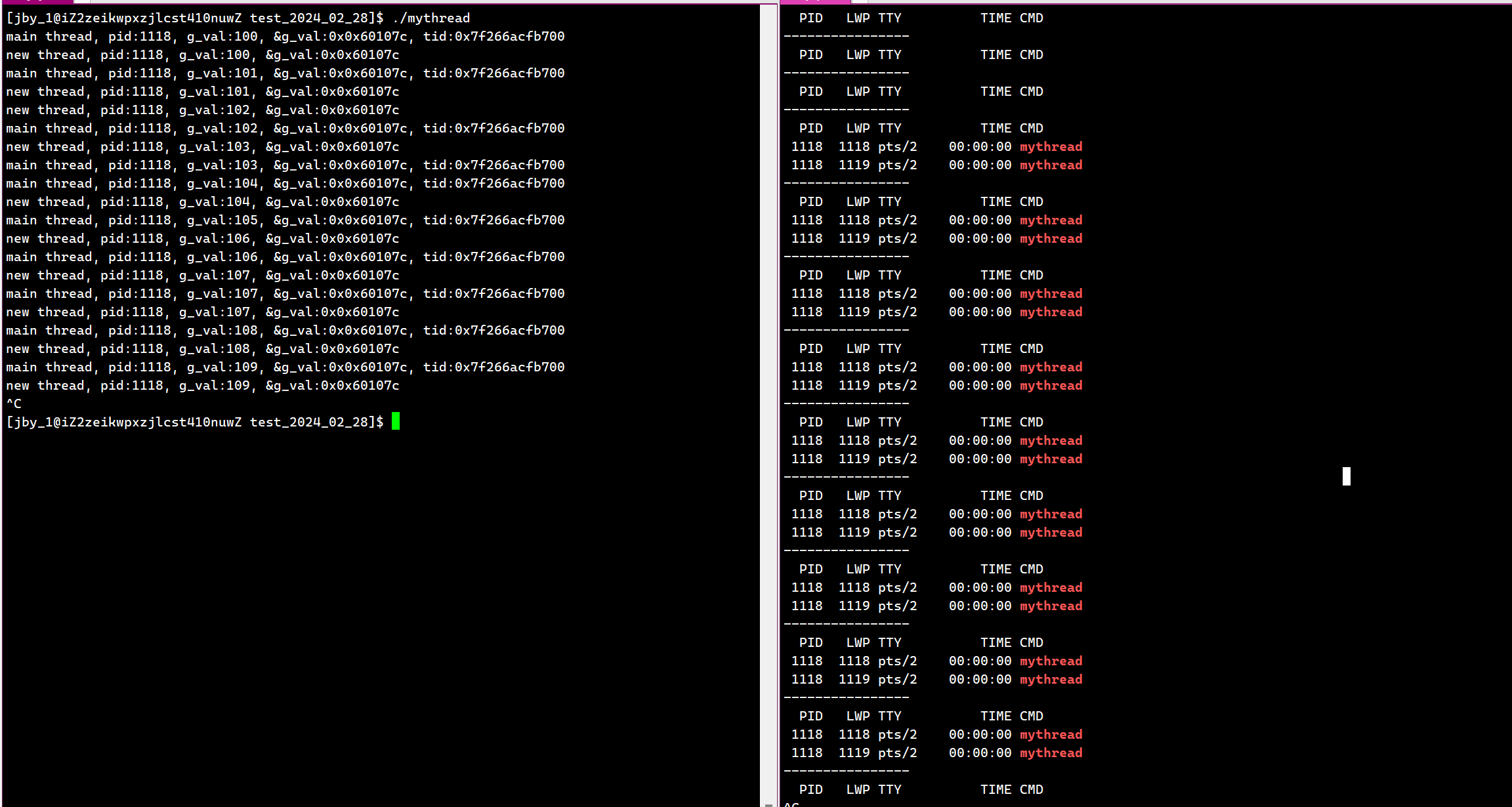
其实这个tid显然不是这个LWP,因为LWP是操作系统认识的就可以了,这tid是我们用户所使用的。至于它的具体使用,我们稍后再谈。
我们再来看看第四个参数,这个第四个参数是给第三个函数进行传参的。
#include <iostream>
#include <pthread.h>
#include <string>
#include <unistd.h>
using namespace std;
int g_val = 100;void show(const string& name)
{cout << name << "say# " << "hello thread" << endl;
}void* threadRountine(void* args)
{const char* name = (const char*)args;while(true){printf("%s, pid:%d, g_val:%d, &g_val:0x%p\n", name, getpid(), g_val, &g_val);// cout << "new thread, pid" << getpid() << endl;//show("[new thread]");sleep(1);// int a = 10;// a = a / 0;}
}int main()
{pthread_t tid;pthread_create(&tid, nullptr, threadRountine, (void*)"thread 1");while(true){printf("main thread, pid:%d, g_val:%d, &g_val:0x%p, creat new thread tid:%p\n", getpid(), g_val, &g_val, tid);// cout << "main thread, pid" << getpid() << ", g_val" << g_val << "&g_val" << &g_val << endl;//show("[main thread]");g_val++;sleep(1);}return 0;
}
运行结果为
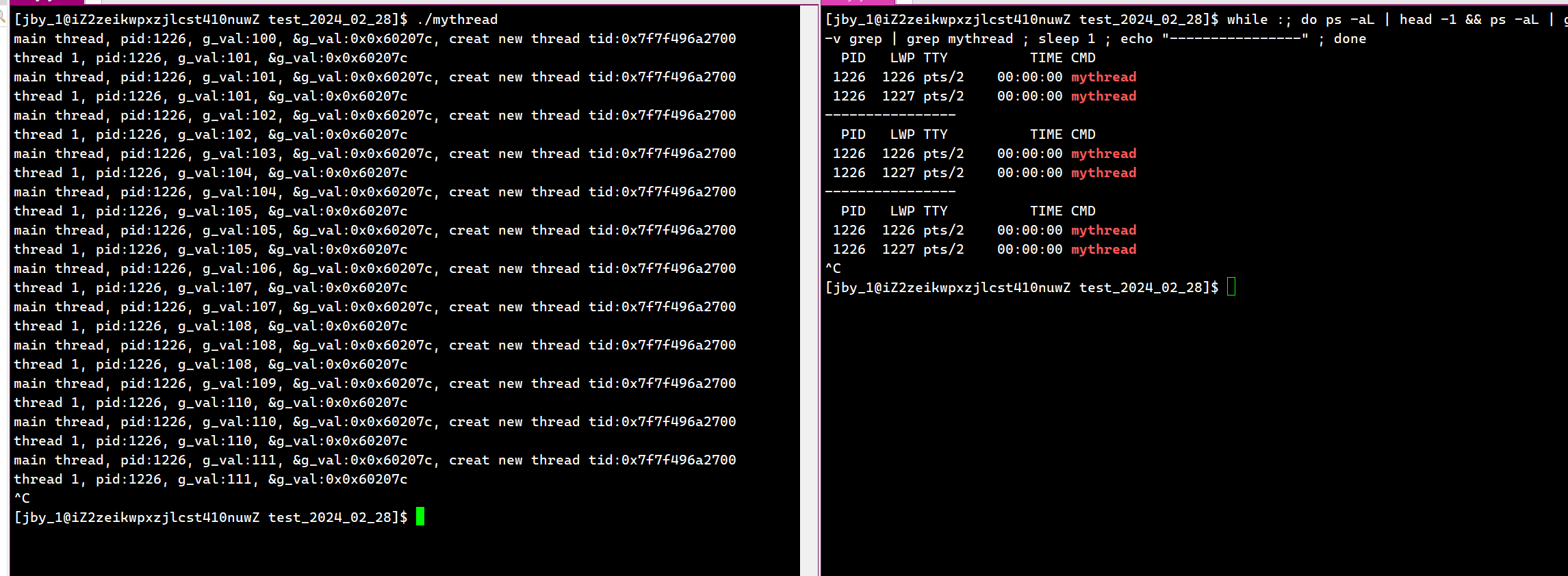
我们果然看到这个第四个参数被传入了进去
2.2 线程等待
那么这两个线程谁先进行退出呢?一般来说是新线程先退出的,然后主线程才能退出的,因为是主线程创建的它,它要对这个新线程进行管理。
如果我们主线程是一个死循环,而新线程一直不退出,那么也会造成类似于进程中的僵尸进程的问题(当然线程里没有这个说法)。所以新线程被创建出来以后,一般也要被等待,如果不等待,可能会造成类似于僵尸进程的问题。当然这个问题我们是无法验证出来的,因为新线程一退,我们查也就查不到了。但是确确实实会存在这个问题。
更重要的是,我们将新线程创建出来,就是让他就办事的,我们得知道它办的怎么样,结果数据是什么?
所以我们线程等待的两个目的:
- 防止内存泄漏
- 如果需要,我们也可以获取一下子进程的退出结果
下面是线程等待的函数
#include <pthread.h>
int pthread_join(pthread_t thread, void **retval);
//Compile and link with -pthread.
如果成功返回0,失败返回错误码。注意:线程里面所有的函数都不用errno错误码,而是直接返回一个错误码。这就保证了所有的线程都可以有一个返回的错误码,不需要去抢占全局的那个变量
关于参数:
第一个参数是线程的tid
第二个参数是该线程结束时的返回值。注意*retval才是void*类型,也就是*retval才是函数的返回值
如下图所示,当void*通过pthread_join的方式传递的时候,会产生一个临时变量。比如说,我们调用函数的时候传递&x,那么&x其实会被拷贝一份,我们这里暂且记作retavl。然后在pthread_join内部执行,*retval = z这一步。最终就成功的为x赋值了。即x就相当于一个输入型参数。
我们可以用如下代码来进行操作一下
#include <iostream>
#include <pthread.h>
#include <string>
#include <unistd.h>
using namespace std;
int g_val = 100;void show(const string& name)
{cout << name << "say# " << "hello thread" << endl;
}void* threadRountine(void* args)
{const char* name = (const char*)args;int cnt = 5;while(true){printf("%s, pid:%d, g_val:%d, &g_val:0x%p\n", name, getpid(), g_val, &g_val);// cout << "new thread, pid" << getpid() << endl;//show("[new thread]");sleep(1);// int a = 10;// a = a / 0;cnt--;if(cnt == 0){break;}}return nullptr; //走到这里就默认线程退出了。
}int main()
{pthread_t tid;pthread_create(&tid, nullptr, threadRountine, (void*)"thread 1");// while(true)// {// printf("main thread, pid:%d, g_val:%d, &g_val:0x%p, creat new thread tid:%p\n", getpid(), g_val, &g_val, tid);// // cout << "main thread, pid" << getpid() << ", g_val" << g_val << "&g_val" << &g_val << endl;// //show("[main thread]");// g_val++;// sleep(1);// }sleep(7);pthread_join(tid, nullptr);cout << "main thread quit..." << endl; return 0;
}
运行结果为:
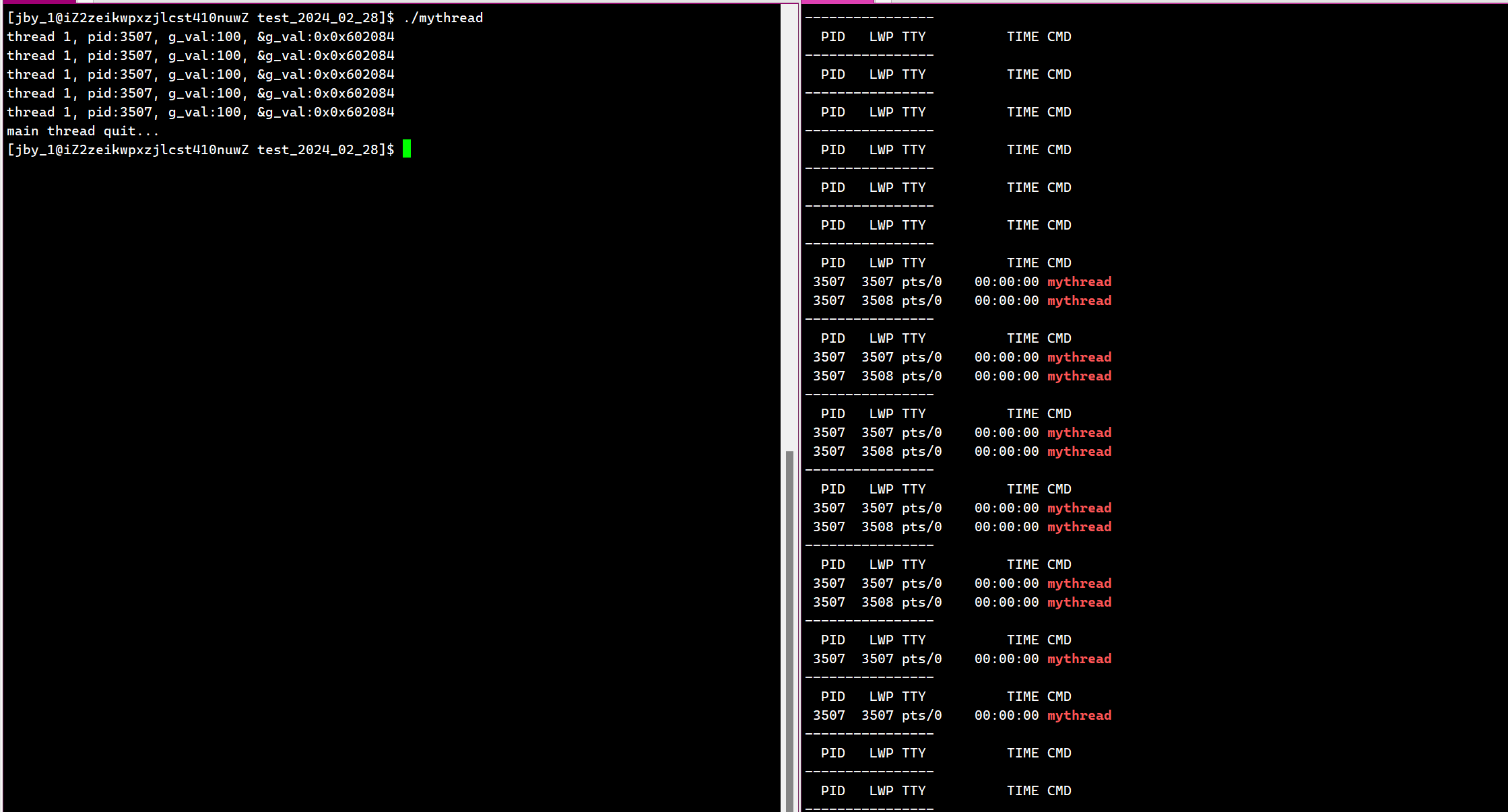
我们可以很明显的看到,新线程先退出了,主线程等两秒之后也就退出了。这里我们观察不到新线程有类似于僵尸的状态,但是确确实实是存在的这个状态
我们现在来使用一下第二个参数retval
#include <iostream>
#include <pthread.h>
#include <string>
#include <unistd.h>
using namespace std;
int g_val = 100;void show(const string& name)
{cout << name << "say# " << "hello thread" << endl;
}void* threadRountine(void* args)
{const char* name = (const char*)args;int cnt = 5;while(true){printf("%s, pid:%d, g_val:%d, &g_val:0x%p\n", name, getpid(), g_val, &g_val);// cout << "new thread, pid" << getpid() << endl;//show("[new thread]");sleep(1);// int a = 10;// a = a / 0;cnt--;if(cnt == 0){break;}}//return nullptr; //走到这里就默认线程退出了。return (void*)1; //走到这里就默认线程退出了。
}int main()
{pthread_t tid;pthread_create(&tid, nullptr, threadRountine, (void*)"thread 1");// while(true)// {// printf("main thread, pid:%d, g_val:%d, &g_val:0x%p, creat new thread tid:%p\n", getpid(), g_val, &g_val, tid);// // cout << "main thread, pid" << getpid() << ", g_val" << g_val << "&g_val" << &g_val << endl;// //show("[main thread]");// g_val++;// sleep(1);// }//sleep(7);void* retval;pthread_join(tid, &retval); //main thread等待的时候,默认是阻塞等待的cout << "main thread quit..., ret: " << (long long)retval << endl; return 0;
}运行结果为,可以看到我们确实已经拿到了1

不过这里我们会感觉到哪里不对劲,为什么我们在这里join的时候不考虑异常呢??
其实是因为做不到,因为线程一旦出异常了,主线程也就挂了。所以线程这里不用考虑异常,异常这里是进程考虑的。
2.3 线程终止
如果我们想要终止线程,能否像进程终止一样使用exit函数呢?
我们可以用下面代码来验证一下
#include <iostream>
#include <pthread.h>
#include <string>
#include <cstdlib>
#include <unistd.h>
using namespace std;
int g_val = 100;void show(const string& name)
{cout << name << "say# " << "hello thread" << endl;
}void* threadRountine(void* args)
{const char* name = (const char*)args;int cnt = 5;while(true){printf("%s, pid:%d, g_val:%d, &g_val:0x%p\n", name, getpid(), g_val, &g_val);// cout << "new thread, pid" << getpid() << endl;//show("[new thread]");sleep(1);// int a = 10;// a = a / 0;cnt--;if(cnt == 0){break;}}exit(11);//return nullptr; //走到这里就默认线程退出了。//return (void*)1; //走到这里就默认线程退出了。
}int main()
{pthread_t tid;pthread_create(&tid, nullptr, threadRountine, (void*)"thread 1");// while(true)// {// printf("main thread, pid:%d, g_val:%d, &g_val:0x%p, creat new thread tid:%p\n", getpid(), g_val, &g_val, tid);// // cout << "main thread, pid" << getpid() << ", g_val" << g_val << "&g_val" << &g_val << endl;// //show("[main thread]");// g_val++;// sleep(1);// }//sleep(7);void* retval;pthread_join(tid, &retval); //main thread等待的时候,默认是阻塞等待的cout << "main thread quit..., ret: " << (long long)retval << endl; return 0;
}
运行结果为
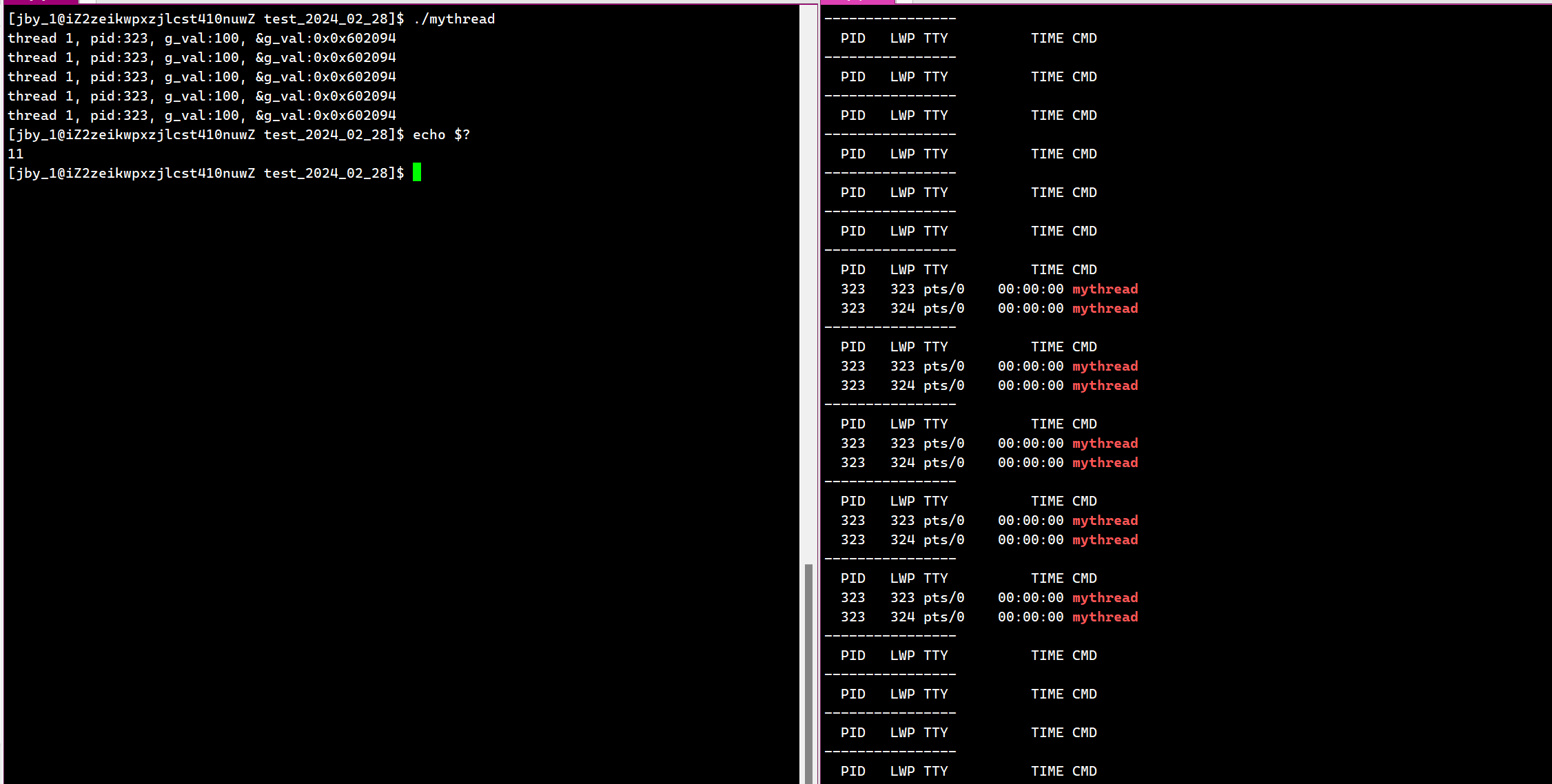
我们可以注意到,主线程并没有打印出对应的main thread quit…。所以说明exit直接将主线程也终止了。
即exit是用来终止进程的!,不能用来直接终止线程
线程终止的接口如下所示:
#include <pthread.h>
void pthread_exit(void *retval);
//Compile and link with -pthread.
它的作用是终止调用这个函数的线程,谁调用它就终止谁。参数是void*,和这个函数的返回值的含义是一样的。
我们用如下代码来进行测试
#include <iostream>
#include <pthread.h>
#include <string>
#include <cstdlib>
#include <unistd.h>
using namespace std;
int g_val = 100;void show(const string& name)
{cout << name << "say# " << "hello thread" << endl;
}void* threadRountine(void* args)
{const char* name = (const char*)args;int cnt = 5;while(true){printf("%s, pid:%d, g_val:%d, &g_val:0x%p\n", name, getpid(), g_val, &g_val);// cout << "new thread, pid" << getpid() << endl;//show("[new thread]");sleep(1);// int a = 10;// a = a / 0;cnt--;if(cnt == 0){break;}}pthread_exit((void*)100);//exit(11);//return nullptr; //走到这里就默认线程退出了。//return (void*)1; //走到这里就默认线程退出了。
}int main()
{pthread_t tid;pthread_create(&tid, nullptr, threadRountine, (void*)"thread 1");// while(true)// {// printf("main thread, pid:%d, g_val:%d, &g_val:0x%p, creat new thread tid:%p\n", getpid(), g_val, &g_val, tid);// // cout << "main thread, pid" << getpid() << ", g_val" << g_val << "&g_val" << &g_val << endl;// //show("[main thread]");// g_val++;// sleep(1);// }//sleep(7);void* retval;pthread_join(tid, &retval); //main thread等待的时候,默认是阻塞等待的cout << "main thread quit..., ret: " << (long long)retval << endl; return 0;
}
运行结果为
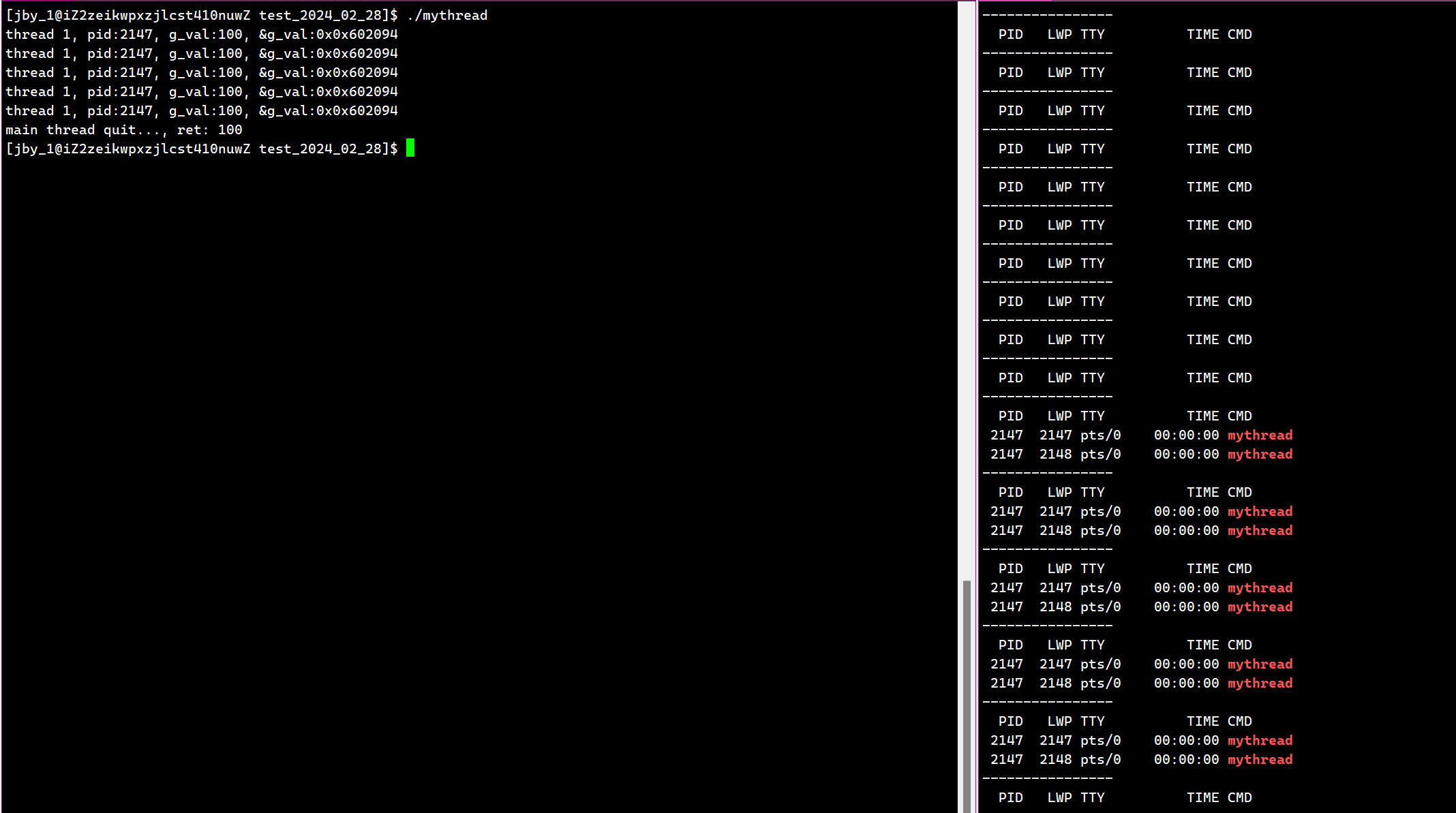
上面是新线程去调用pthread_exit接口,那么只有这个线程会退出,如果主线程去调用这个接口退出的话,那么整个进程都会终止
2.4 线程取消
如下所示,是线程取消的接口。
#include <pthread.h>
int pthread_cancel(pthread_t thread);
//Compile and link with -pthread.
我们用如下代码来进行验证
#include <iostream>
#include <pthread.h>
#include <string>
#include <cstdlib>
#include <unistd.h>
using namespace std;
int g_val = 100;void show(const string& name)
{cout << name << "say# " << "hello thread" << endl;
}void* threadRountine(void* args)
{const char* name = (const char*)args;int cnt = 5;while(true){printf("%s, pid:%d, g_val:%d, &g_val:0x%p\n", name, getpid(), g_val, &g_val);// cout << "new thread, pid" << getpid() << endl;//show("[new thread]");sleep(1);// int a = 10;// a = a / 0;cnt--;if(cnt == 0){break;}}//pthread_exit((void*)100);//exit(11);//return nullptr; //走到这里就默认线程退出了。//return (void*)1; //走到这里就默认线程退出了。
}int main()
{pthread_t tid;pthread_create(&tid, nullptr, threadRountine, (void*)"thread 1");// while(true)// {// printf("main thread, pid:%d, g_val:%d, &g_val:0x%p, creat new thread tid:%p\n", getpid(), g_val, &g_val, tid);// // cout << "main thread, pid" << getpid() << ", g_val" << g_val << "&g_val" << &g_val << endl;// //show("[main thread]");// g_val++;// sleep(1);// }//sleep(7);sleep(1); //保证新线程已经启动pthread_cancel(tid);void* retval;pthread_join(tid, &retval); //main thread等待的时候,默认是阻塞等待的cout << "main thread quit..., ret: " << (long long)retval << endl; return 0;
}
运行结果为
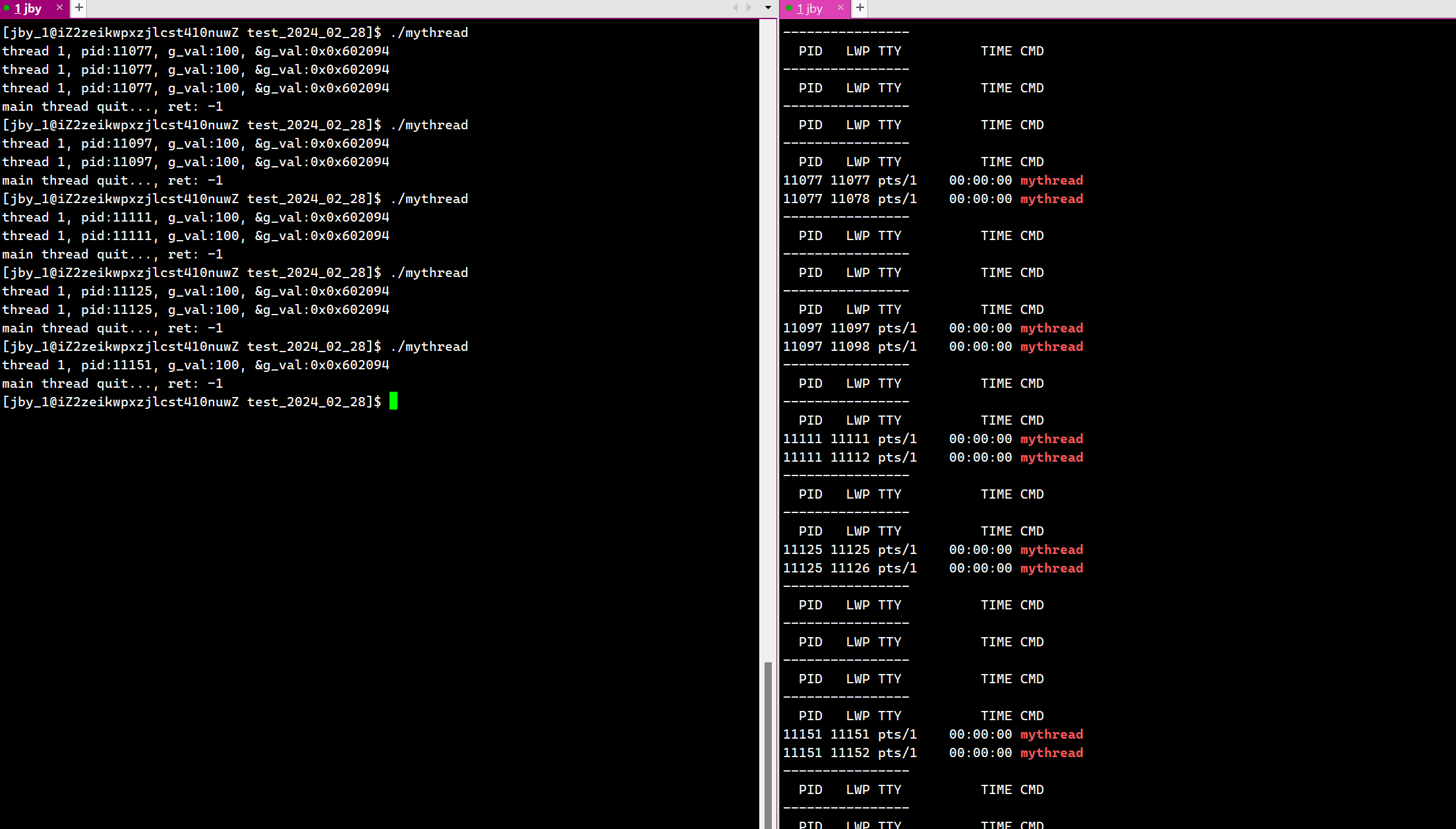
我们可以注意到,此时这个线程等待以后的返回值为-1
其实是因为一个线程如果被取消的话,会有这样一个宏
#define PTHREAD_CANCELED ((void *) -1)
换句话说,如果线程是被取消的,那么它退出时的返回码就是-1,即上面的宏
2.5 综合使用前面的四个接口
其实线程的参数和返回值,不仅仅可以用来传递一般参数,也可以传递对象
我们可以用下面的代码来看
#include <iostream>
#include <pthread.h>
#include <string>
#include <cstdlib>
#include <unistd.h>
using namespace std;class Request
{
public:Request(int start, int end, const string& threadname):_start(start),_end(end),_threadname(threadname){}
public:int _start;int _end;string _threadname;
};
class Response
{
public:Response(int result, int exitcode):_result(result),_exitcode(exitcode){}
public:int _result; //计算结果int _exitcode; //计算结果是否可靠
};void* sumCount(void* args) //线程的参数和返回值,不仅仅可以用来传递一般参数,也可以传递对象
{Request *rq = static_cast<Request*>(args);Response *rsp = new Response(0, 0);for(int i = rq->_start; i <= rq->_end; i++){cout << rq->_threadname << " is runing, caling..., " << i << endl;rsp->_result += i;usleep(100000);}delete rq;return (void*)rsp;
}int main()
{pthread_t tid;Request* rq = new Request(1, 100, "thread 1"); pthread_create(&tid, nullptr, sumCount, rq);void* ret;pthread_join(tid, &ret);Response *rsp = static_cast<Response*>(ret);cout << "rsp->result: " << rsp->_result << ", exitcode: " << rsp->_exitcode << endl; delete rsp;return 0;
}运行结果为
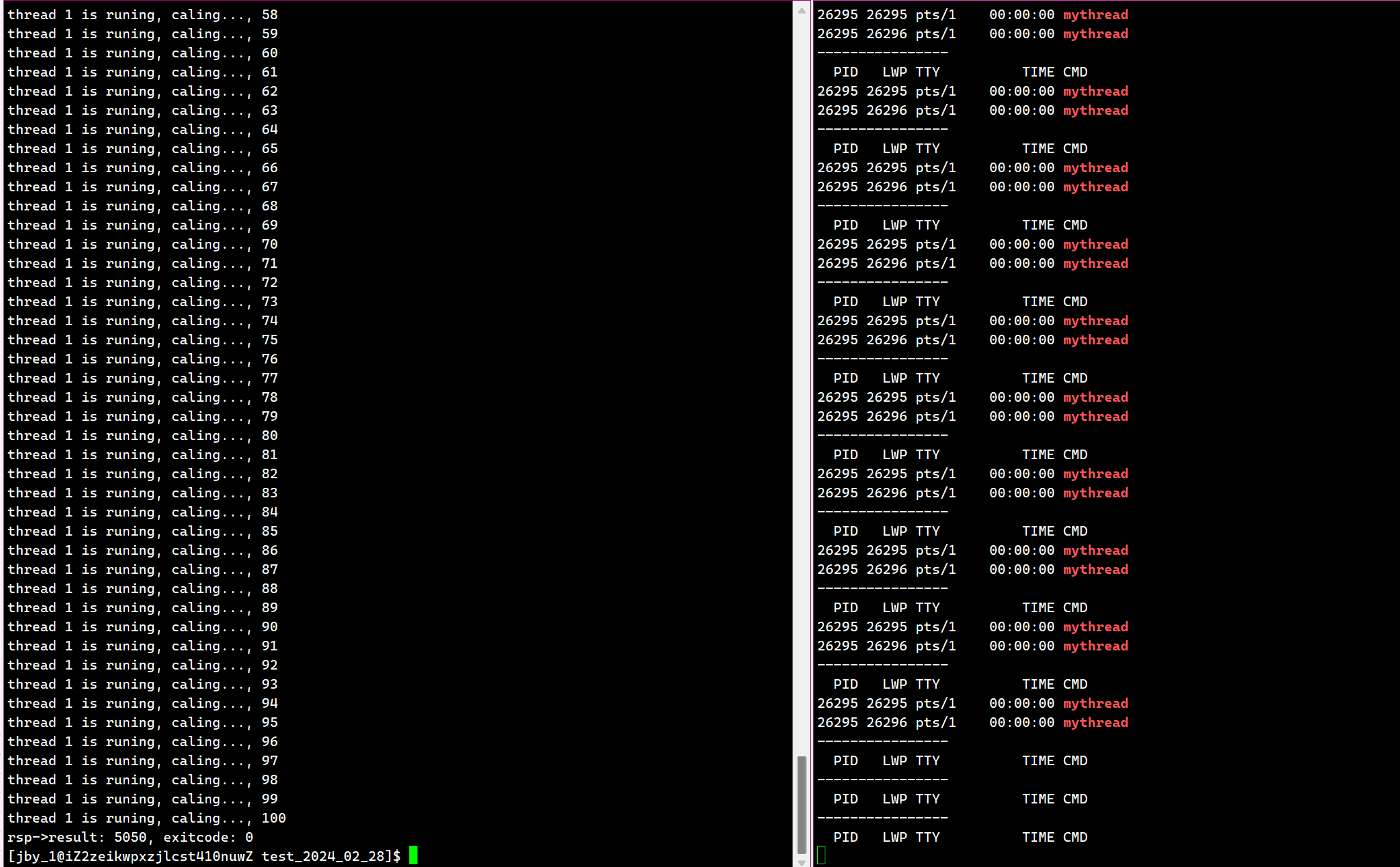
所以它就可以用来求出和。让每一个线程只执行其中的一部分计算,然后我们自己在将这些结果合并起来。
并且我们发现,我们的这些对象都是在堆区创建的。并且我们是交叉使用的,说明堆空间的也是被线程共享使用的
2.6 C++11中的线程
目前,我们使用的是原生线程库(pthread库)
其实C++11 语言本身也已经支持多线程了,它与我们的原生线程库有什么关系呢?
C++11的线程需要用下面的库
#include<thread>
我们看下面的代码
#include <iostream>
#include <pthread.h>
#include <string>
#include <cstdlib>
#include <unistd.h>
#include <thread>
using namespace std;
void threadrun()
{while(true){cout << "I am a new thread for C++" << endl;sleep(1);}
}int main()
{thread t1(threadrun);t1.join();return 0;
}运行结果为
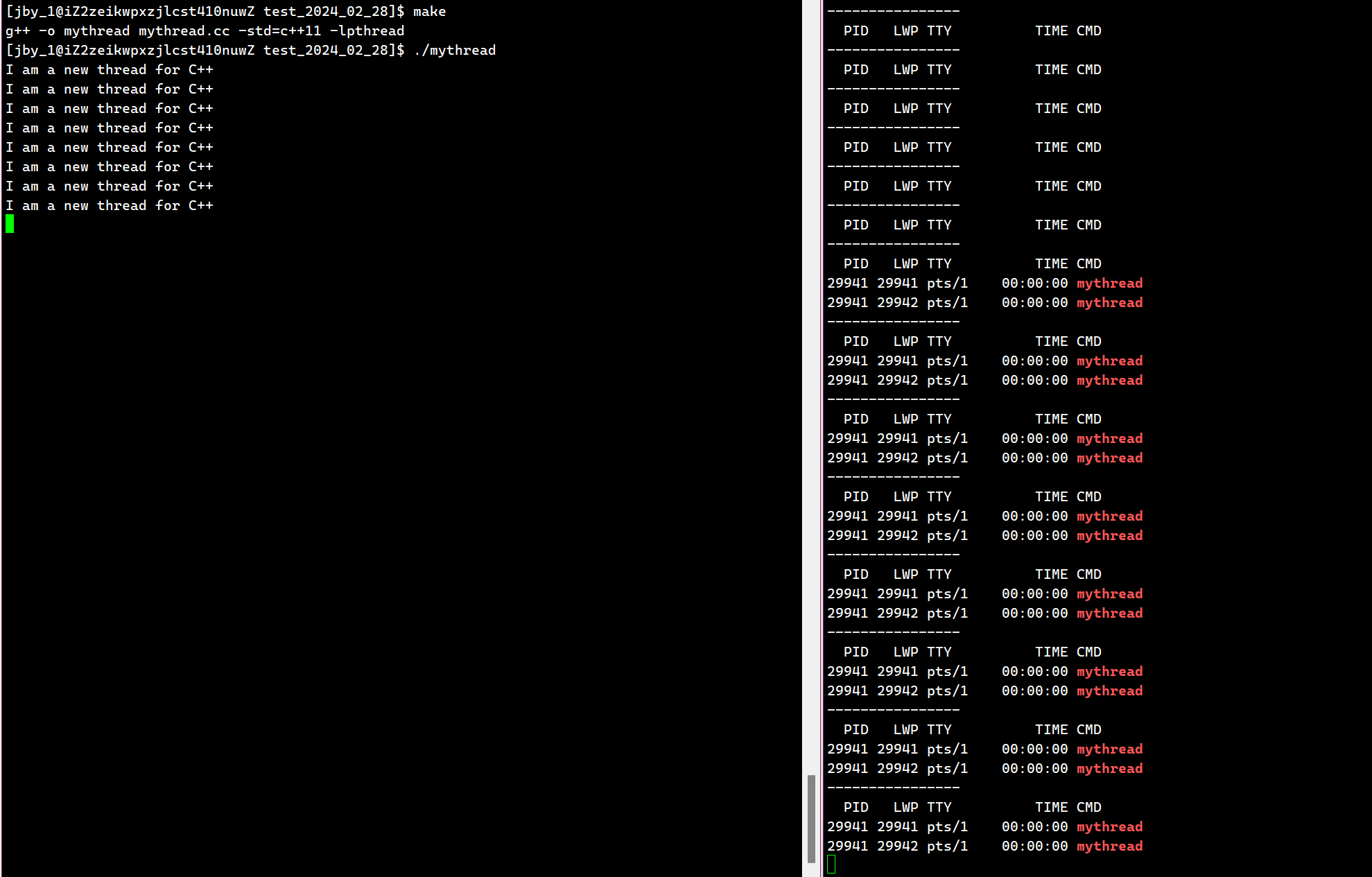
我们需要注意的是,C++11中的线程库其实底层还是封装了linux提供的系统调用接口,所以我们编译的时候还是需要使用-lpthread选项的。
而C++11其实是有跨平台性的。因为它在不同平台下已经写好了不同版本的库。所以对我们而言,不同的平台写代码是没有感觉的。
我们最好使用C++的多线程。因为具有跨平台性
3.线程ID与进程地址空间布局
我们现在还没有解释这个tid究竟是什么东西,我们先看下面的代码
#include <iostream>
#include <pthread.h>
#include <string>
#include <cstdlib>
#include <unistd.h>
#include <thread>
using namespace std;std::string toHex(pthread_t tid)
{char hex[64];snprintf(hex, sizeof(hex), "%p", tid);return hex;
}void *threadRoutine(void *args)
{while(true){cout << "thread id : " << toHex(pthread_self()) << endl; sleep(1);}
}
int main()
{pthread_t tid;pthread_create(&tid, nullptr, threadRoutine, (void*)"thread 1");cout << "main thread create thread done, new thread id: " << toHex(tid) << endl;pthread_join(tid, nullptr);return 0;
}
运行结果为
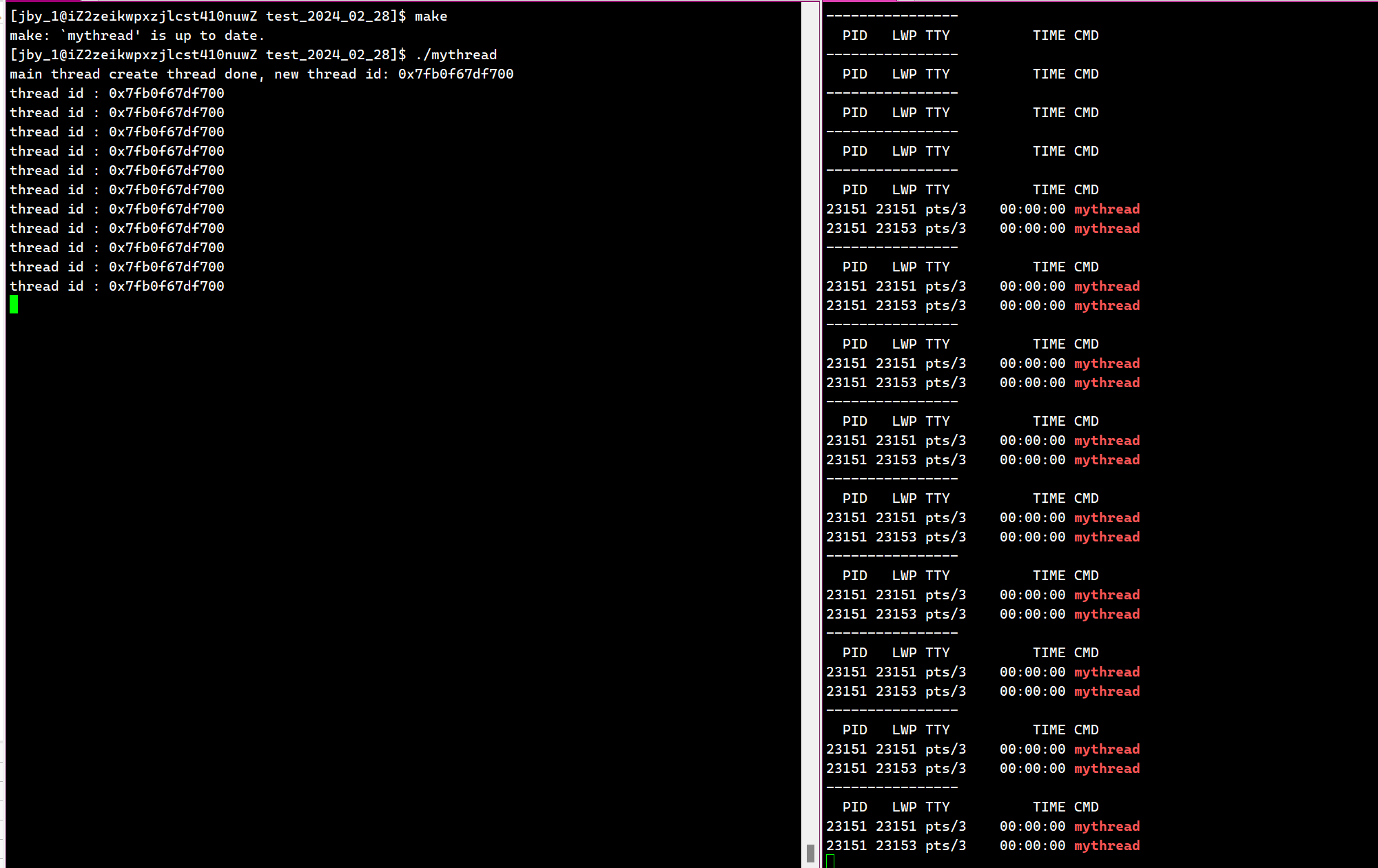
我们知道的是,内核中并没有明确的线程的概念,只有轻量级进程的概念
而轻量级进程接口是这样的

这个接口我们一般是不用的,包括fork的底层其实用的也是这个接口
这个的第一个参数是一个函数指针,第二个参数是自定义的一个栈…
这个接口是被pthread线程库封装了。
所以我们采用的是pthread_create,pthread_join这些接口。
如下图所示,这个clone这个接口它需要提供一个回调函数,独立栈结构等,用它去维护线程。
而这些都是线程库在做的事情,也就是线程的概念是库给我们维护的,我们用的原生线程库,也要加载到内存中,因为都是基于内存的。线程库是一个动态库,经过页表映射后,也要到共享区的。
这些栈都是在共享区创建的。我们的线程库只需要维护线程的概念即可,不用维护线程的执行流,不过线程库注定了要维护多个线程属性集合,线程也要管理这些线程,先描述在组织。
而这个线程控制块它就要可以找到这些回调函数,独立栈,以及在内部的LWP。这个线程控制块就是用户级线程
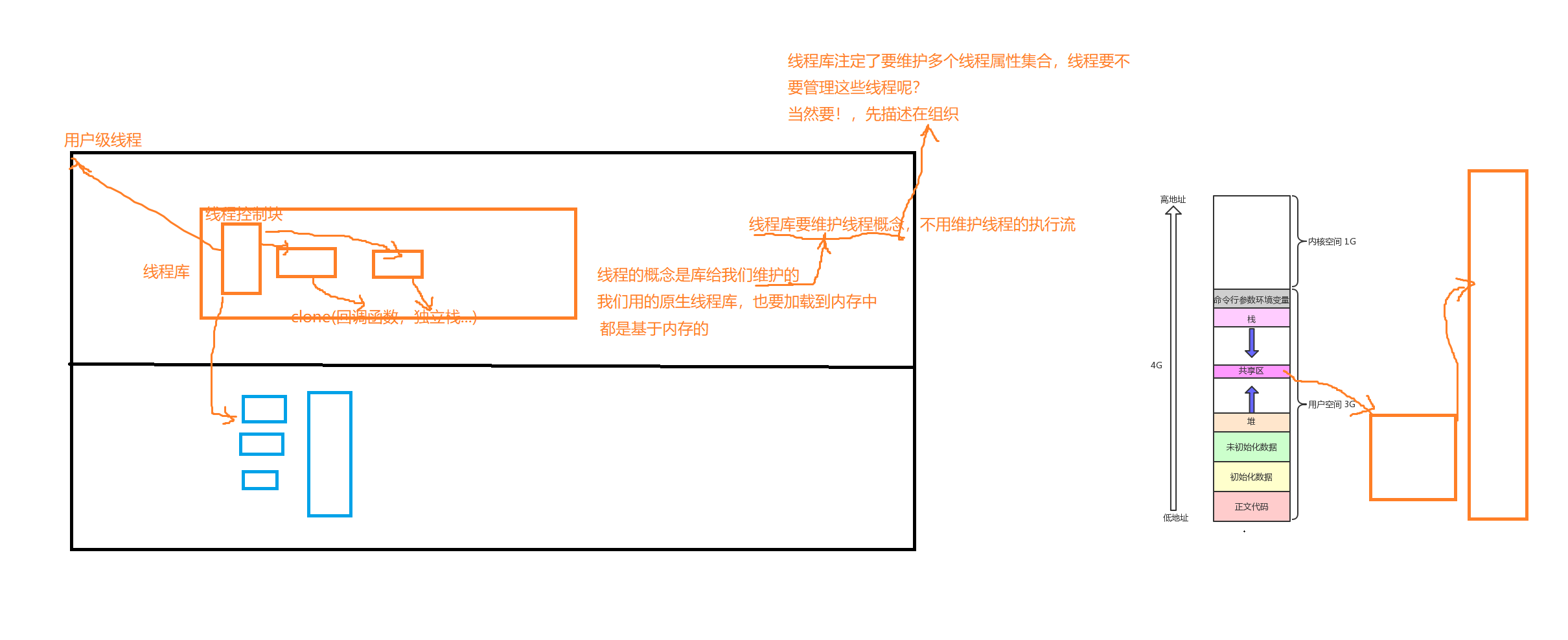
所以我们就将这个下面的这个叫做线程的tcb。而每一个tcb的起始地址,叫做线程的tid
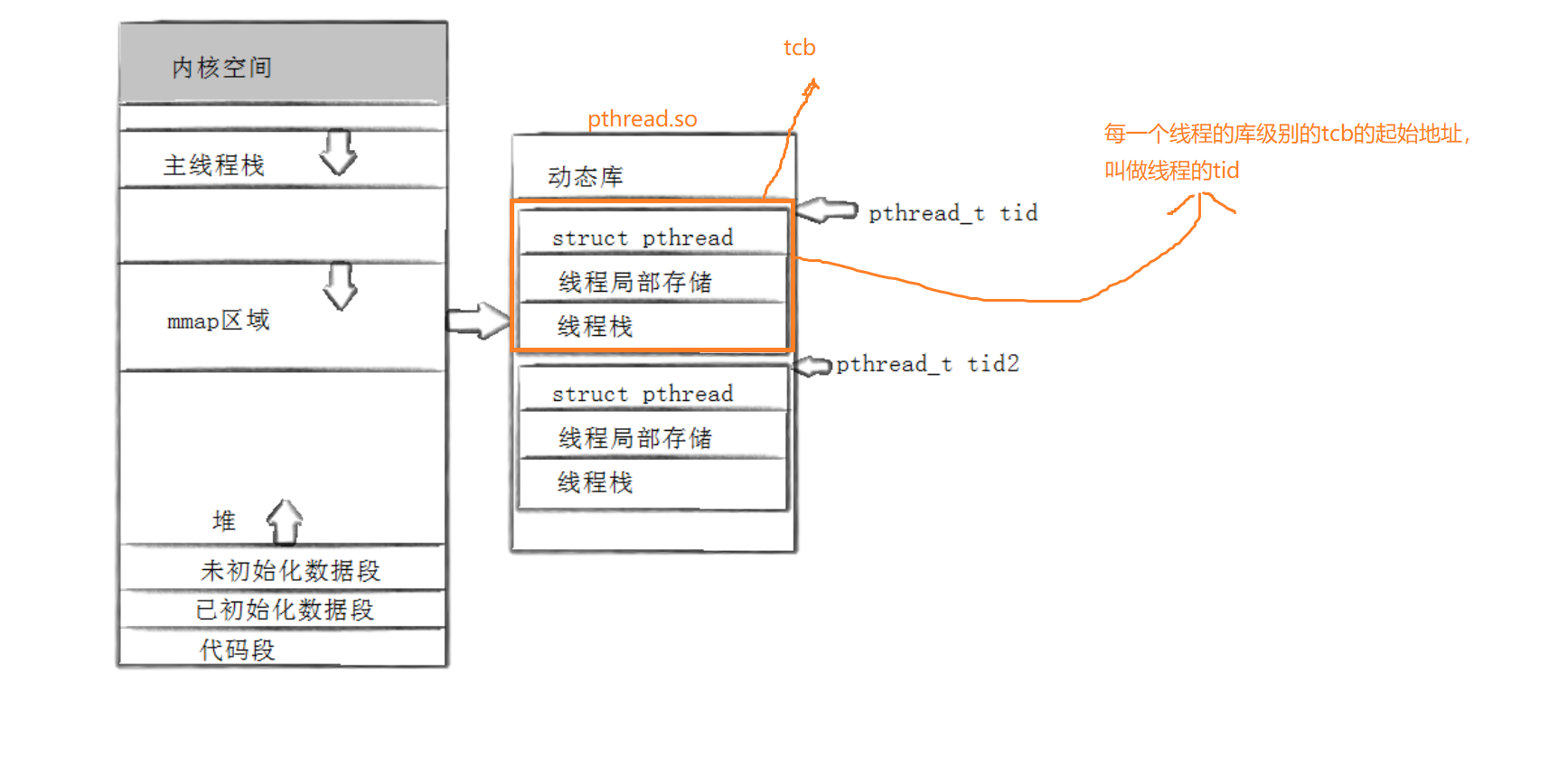
所以拿着这个tid,就可以找到库里面的属性了。
而我们前面打印出来的这个地址,我们也可以看到,它是比较大的,其实它就是介于堆栈之间的共享区
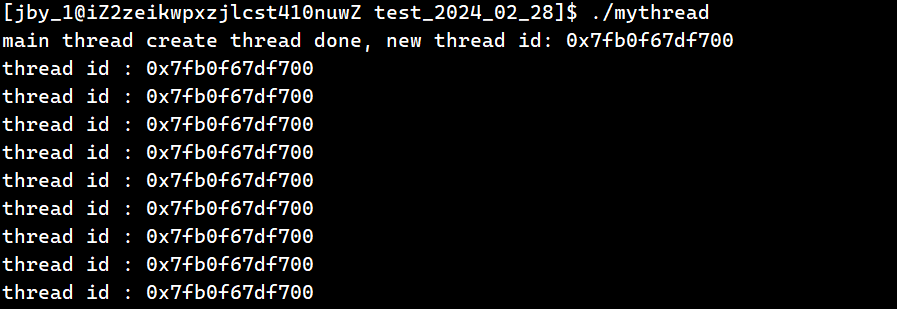
每一个线程都必须要有自己的独立栈结构,因为它有独立的调用链,要进行压栈等操作。其中主线程用的就是地址空间中的这个栈。剩下的轻量级进程在我们创建的时候会先创建一个tcb,它里面的起始地址作为线程tid,它的里面有一个默认大小的空间,叫做线程栈,然后内核中调用clone创建好执行流。在clone中形成的临时数据都会压入到这个线程库中的栈结构中。
即,除了主线程,所有其他线程的独立站,都共享区,具体来讲是在pthread库中,tid指向的用户tcb中
所以其实Linux的线程 = 用户级线程 + 内核的LWP
线程可以分为用户级线程和内核级线程,而linux就属于用户级线程
在linux中, 每一个用户级线程就要对应内核中的一个LWP。用户级执行流:内核LWP = 1 : 1
- pthread_ create函数会产生一个线程ID,存放在第一个参数指向的地址中。该线程ID和前面说的线程ID不是一回事。
- 前面讲的线程ID属于进程调度的范畴。因为线程是轻量级进程,是操作系统调度器的最小单位,所以需要一个数值来唯一表示该线程。
- pthread_ create函数第一个参数指向一个虚拟内存单元,该内存单元的地址即为新创建线程的线程ID,属于NPTL(原生线程库)线程库的范畴。线程库的后续操作,就是根据该线程ID来操作线程的。
- 线程库NPTL(原生线程库)提供了pthread_ self函数,可以获得线程自身的ID
pthread_t pthread_self(void);
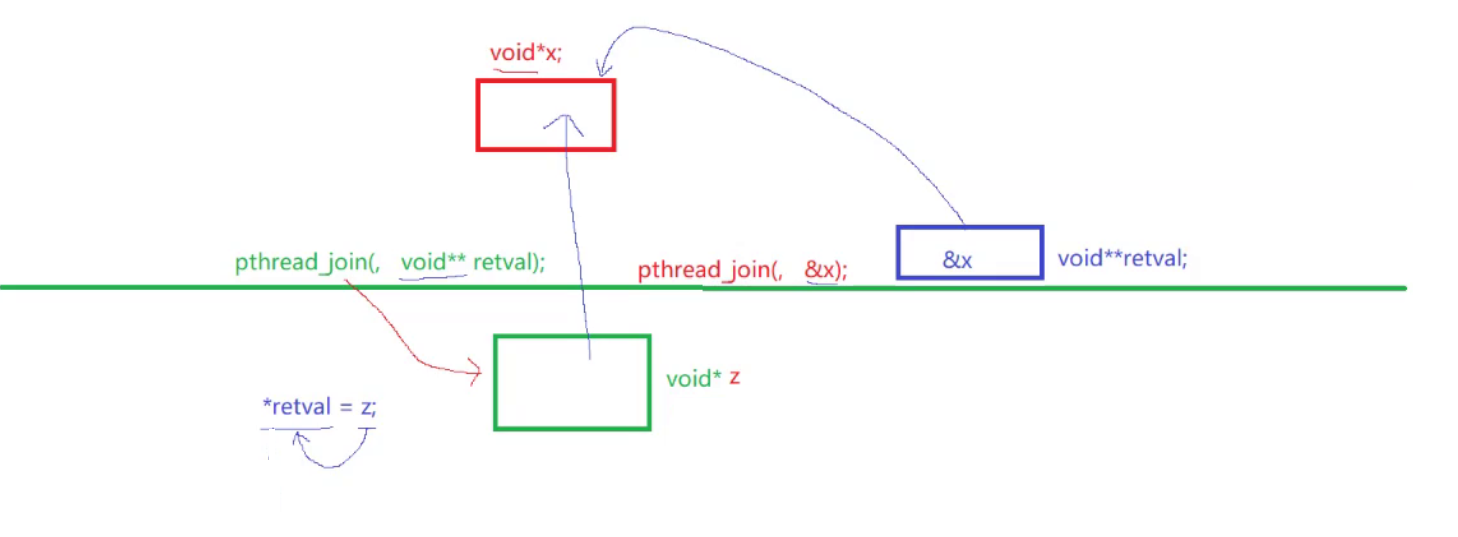

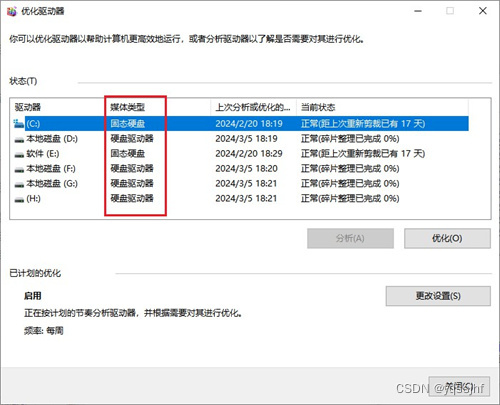



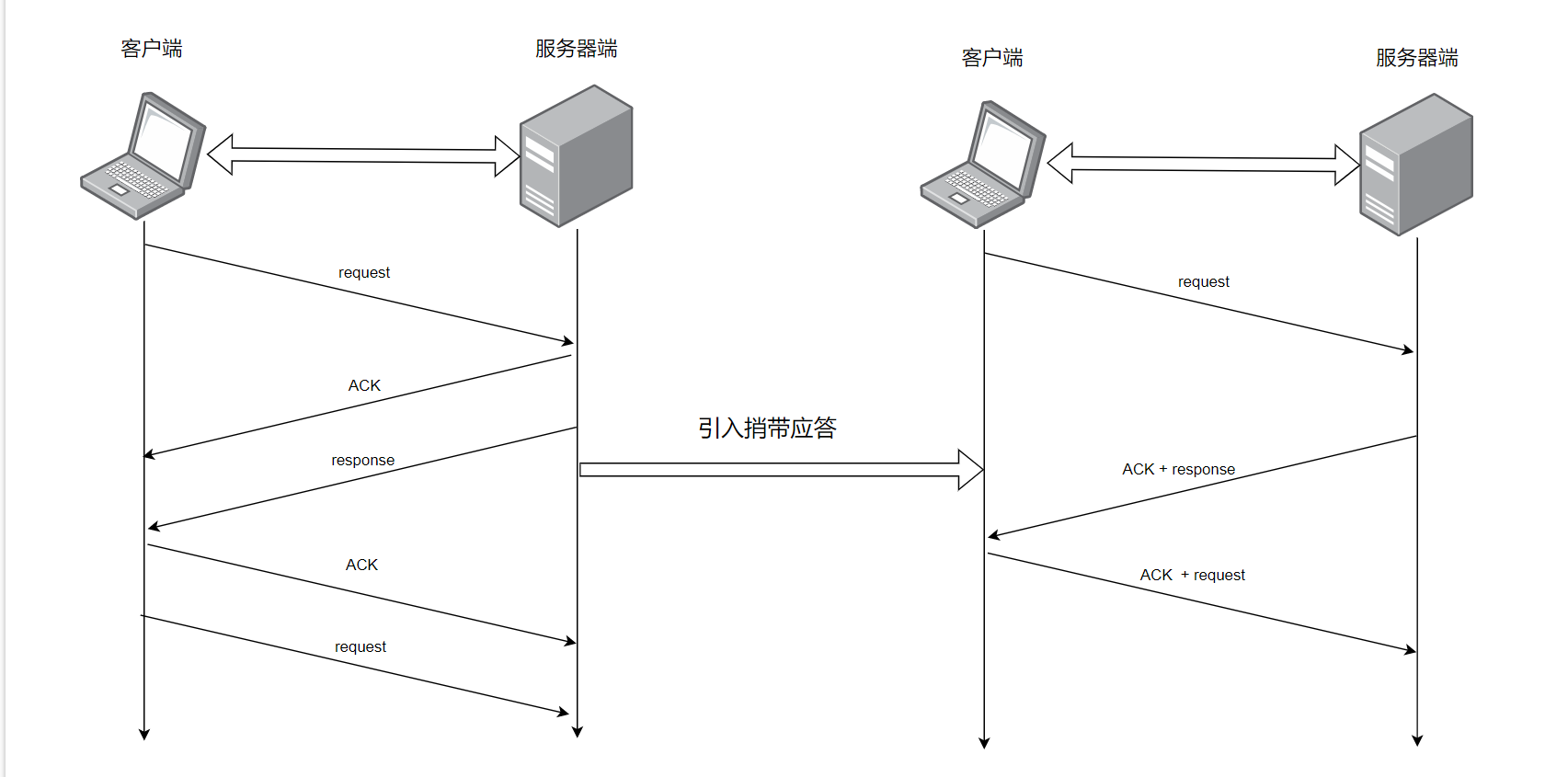




![[java入门到精通] 11 泛型,数据结构,List,Set](https://img-blog.csdnimg.cn/direct/77dc7a6315d443ac9caa6726ec3fe205.png#pic_center)
